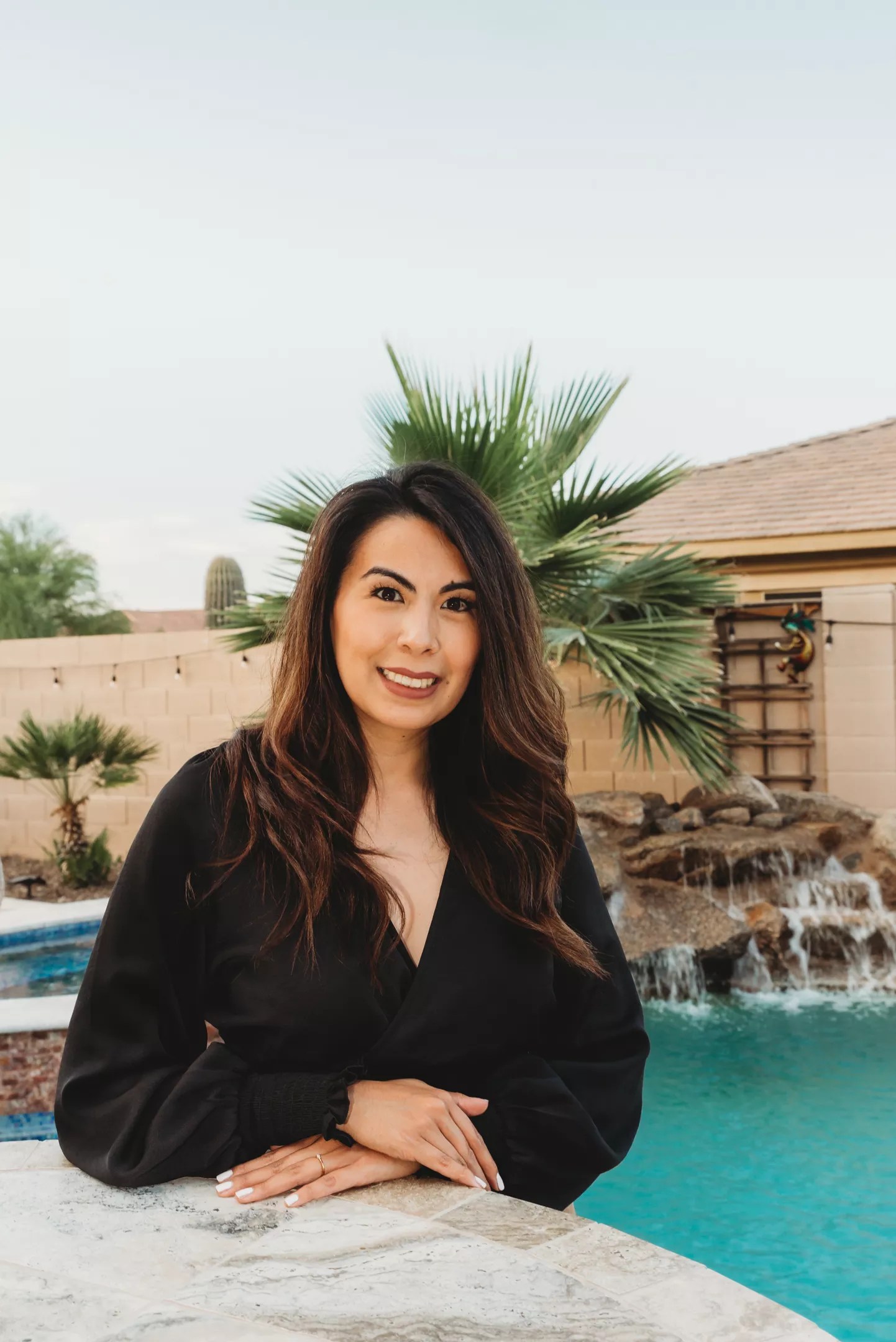
Brittany Johnson from Little Missy Photography

Audio By Carbonatix
We all know Arizonans are on the move. That much is plain from all the out-of-state license plates seen around town, and it’s reflected in soaring housing prices, too.
But the best measure of just how mobile the state has become is seen in change-of-address data kept by the U.S. Postal Service. Last year alone, the post office took in 1.9 million Change-of-Address (COA) registrations in Arizona.
Arizona ZIP codes had 980,000 new inbound registrations, while 935,000 applicants told the postal service they were leaving their Arizona ZIP code.
People file COA forms when they move their primary address. It is a minutes-long procedure done inside a Postal Service facility or on the USPS.com website. It results in a request that the post office reroutes all the applicants’ mail and parcels to a new address for all or selected individuals.
Phoenix New Times analyzed 2021 COA data released by the USPS in January. The data show that the mass migration was driven by out-of-state workers seeking cheaper housing where they could work remotely. But not just that. Snowbirds are returning to the Valley, in part because of relaxing travel restrictions, while skyrocketing rents are forcing many people to move within Maricopa County.
In 2021, more than a million individuals moved within the Phoenix metro area. It’s a staggering number. The population of the entire county is 4.4 million, according to the latest U.S. Census Bureau estimates, meaning more than one in five Phoenix residents pulled up stakes last year.
The city of Phoenix alone had 352,000 change-of-address registrations, while Mesa had 162,000, and Surprise had 46,000.
Since the pandemic started in March 2020, metro Phoenix became the new hub for many California and Washington state transplants. Many kept their out-of-state jobs, wages, and benefits, but dramatically lowered their cost of living. With the lockdown, they joined the new norm of working remotely.
Another thing some transplants kept were their out-of-state license plates while they put off their change-of-address process. It’s a challenge to register and insure a vehicle in Arizona without claiming local residency.
And while many of us might assume the 44,000-plus net COAs in Arizona are related to the out-of-state drivers bogging down rush hour traffic, most moves in metro Phoenix are likely made by our fellow Maricopa County residents.
In July 2021, the U.S. Census Bureau reported that nearly 5 percent of the U.S. population moved within the same county, almost 2 percent within the same state, and 1.4 percent to a different state.
The Postal Service’s COA data breaks it down further. For each ZIP code, it tracks inbound and outbound COAs monthly, as well as total registrations by businesses, families, and individuals, and which are permanent and which are temporary.
It’s no surprise the 1.6 million-plus residents of the city of Phoenix pulled the highest address-change registrations, with about 170,000 families, individuals, and businesses coming into the capital city’s ZIP codes, while nearly 180,000 moved away. It’s by far the biggest city in Arizona.
Some people or businesses relocate within the same ZIP code, but the Postal Service does not report those figures.
Business changes
Still, the data hints at business migration patterns in metro Phoenix, as they grappled with the economic turmoil of the pandemic.
In March 2020, the number of businesses leaving a ZIP code spiked to its highest number of the year. A year later, when Governor Doug Ducey lifted the remaining COVID-19 restrictions on Arizona events and businesses in March 2021, the highest amount of incoming business COA registrations transpired shortly after, throughout April.
To be more specific, the city of Phoenix showed a sharp decline in the total of new inbound business registrations, especially in the 85016 ZIP code, the Biltmore area.
The upscale district is bordered by Lincoln Drive, north of the nearly 100-year-old Arizona Biltmore resort, a little past State Route 51 on its west, Thomas Road to its south, and North 32nd Street to its east.
A little more than three years ago, the Biltmore area pulled the highest amount of incoming business address changes throughout the county in a month. There were 787 registrations in March 2019 alone.
The area has many international eateries and quirky mom-and-pop shops sprawled within the corporate buildings, big box stores, restaurant chain diners, condos, and homes.
But like every other city in America, after Ducey issued an executive order on March 20, 2020, to close down bars and restrict restaurant services to takeout and outdoor dining, everything in the Biltmore area flipped.
“Well, it was tough,” said Rich Bock, who has owned and managed Giuseppe’s on 28th Street for more than 15 years. “After the shutdown, one business after another closed down.”
Giuseppe’s is a popular Biltmore area Italian restaurant in the Sprouts Farmers Market strip mall on East Indian School Road and 28th Street. The restaurant was featured in the New Times‘ 2016 edition of the Best of Phoenix issue and on the Diners, Drive-Ins, and Dives show on the Food Network.
Bock said he considered joining his neighbors in closing the restaurant’s doors. But he didn’t leave and pursued the takeout option instead. Sales dropped to about 50 percent of normal, just enough to keep the family business going until 2021, Bock said.
Many of the restaurants in the area weren’t as fortunate. They couldn’t stay in business solely with takeout orders, so they moved, and many retailers followed suit.
Then, some of the 787 who had just registered for a COA at the 24th Street post office months earlier, brought in moving trucks to empty out the fixtures, supplies, and machinery they had just moved in months earlier, U-Haul data show.
Three of Bock’s neighbors left. “Those places have been vacant for a while,” Bock said.
Another casualty was Bamboo Sushi, nestled in the Biltmore Fashion Park mall. The sushi spot landed on the New Times’ list of “Phoenix-area restaurants that have permanently closed since March 2020.”
In 2020, more than 750 Biltmore businesses registered with the post office to leave the ZIP code.
A year later, one of the county’s hottest go-to ZIP codes for movers and shakers dropped to ninth, with only 94 incoming business COAs in November. That was the high-water mark for Biltmore last year. No month matched it.
The pandemic era annual numbers tell a more dramatic tale. The number of businesses moving into the Biltmore district and registering with the post office fell from 1,419 in 2019 to 519 in 2021.
The Postal Service’s COA data show where the survivors moved once the country got a better handle on the virus in 2021.
About 12 miles northeast of the Biltmore area is North Scottsdale’s 85254 ZIP code. In April 2021, 213 businesses moved to this part of Scottsdale and registered with the post office, the highest monthly count for all of last year. That’s only a quarter of the companies that registered in the Biltmore area in a single month prior to the pandemic.
Throughout last year, 176 more incoming businesses registered an address change at this ZIP code than in 2019. The area is home to Stonecreek Golf Club and Orange Tree Golf Course.
The adjoining ZIP code to the east, 85255, took a close second in the incoming business COAs. That’s where Grayhawk Golf Club, TPC Scottsdale, and McDowell Mountain Golf Club are located.
Golf courses, considered essential businesses during the pandemic, remained open to the public during 2020 while much of everything else closed down.
In 2021, both North Scottsdale ZIP codes netted 300 business COAs.
Bock, the Italian restaurant owner back in central Phoenix, said he wishes to move to this part of Scottsdale, but estimates rent is about three times higher than what he’s paying now at the Biltmore area
Families and Snowbirds
Family migrations spiked on the other end of the Valley.
In 2021, Sun City West had the highest registrations in family-based COAs to a specific ZIP code throughout metro Phoenix, many from California.
But for California parents looking to advance their kids into the metro Phoenix public school district, Arizona’s open enrollment policy is a sigh of relief. California policies hinder parents from freely selecting their kids’ best public school options.
For instance, Sun City West received an overall B-plus in the public school section on Niche.com, which provides school and neighborhood data. But transplants can send their kids to the neighboring Peoria school district, which Niche gave an A-minus grade.
For families moving in, the USPS enables a household in which everyone shares a surname to register a new address collectively in a single application. But if some family members have different last names, or not all family members are moving, each person moving files a change of address request as an individual.
Consequently, it’s not always clear from family registrations how many people have moved. But what is certain: Sun City West pulled the highest numbers of inbound families within Maricopa County’s 131 ZIP codes in October 2021. That month, 1,051 families registered to move within the city’s 85375 ZIP code.
Shannon Carlson, of eXp Realty/The Garcia Group in Litchfield Park, filed for a COA in 2018 when she uprooted her four kids from Rancho San Diego, California, and moved them to Buckeye for a “better quality of life.” She’s ecstatic about the larger pool of public school options she has in the West Valley.

Shannon Carlson — who shows recent transplants, fun locales, and property listings on her Instagram — filed for a change of address in 2018.
Brittany Johnson from Little Missy Photography
But she said an older age bracket explains the trends in Sun City West.
“Snowbirds are why there’s a high number of temporary COAs there,” Carlson said. “The Arizona snowbird timeline is typically from October to May, then they go back to cooler summers, elsewhere.” May 2021 numbers show 1,766 individuals and families registered to leave the Sun City West ZIP Code, the second highest in Arizona.
Carlson noted that Sun City West is one of the largest retirement cities in the nation. And she’s noticed that younger families are drawn to the community because they’d rather be closer to elderly families than the more active and younger folks living by frat houses or bustling hipster bars on the other side of town.
Carlson recounted when her family first moved. “At the time, it was important to change my address to Arizona for tax purposes, my real estate license, and associate with being a local in my new city,” she said.
Transplants happily paid lower income and property taxes than in California, thanks to the change-of-address process. Carlson adds that most interstate transplants she has met migrated from – in order of highest to lowest numbers – California, Washington, Colorado, and then Texas.
Diego Cruz from the Society of St. Vincent de Paul thrift store in Surprise agreed, but added Canada to the list. “A few new people come in, mostly snowbirds from the older age group,” he said. “And we are right across from Sun City West.”
New transplants on the Living North Phoenix Facebook page, 10,000 members strong, advise people moving to metro Phoenix to sell as much as possible before trekking in – and to keep only the bare essentials that fit inside their vehicles. Movers do this to avoid spending thousands of dollars renting a moving truck and hiring movers. Then, once the transplants arrive in the Phoenix area and get settled in, they can buy back the furniture, and household goods from Craigslist, Facebook Marketplace, OfferUp – and thrift stores like the one Cruz manages.
“The snowbirds usually look for large pieces of nice quality furniture,” Cruz corroborated. “They are always looking to furnish their houses when they move in.”
In October alone, 1,022 families moved by Cruz’s store at the 85374 ZIP code in Surprise, the second-highest total by that measure countywide.
But Cruz says there’s not too much of a selection for kids’ products in his store yet, as most of their clients are from the Surprise and Sun City West retirement communities. Donations tend to be local.
Housing Prices
“In 2019, homes in Sun City West were selling on average around $350K,” Carlson noted. “In 2021, homes on average sold at a record high, $450K. And Sun City West continues to be one of the desirable places to retire early in the U.S. because of its golf courses, dining, and outdoor activities.”
Surprise’s median home price increased from $258,000 in January 2019 to $440,000 in March of this year, according to Zillow. But for many out-of-staters, it’s still a bargain.
A 45-year-old health-and-fitness coach, Jen Raymond recently made a change of address from West Seattle to the Ashton Ranch neighborhood in Surprise. “I moved to Arizona to escape commie Washington,” she said, “We bought a house with a pool in Surprise where the mortgage is half of what we were paying for rent in Seattle,” adding that she paid $4,000 a month there for a three-bedroom and two-bath home with no backyard.
On the other side of the Valley, Mesa ranked 18th in the U.S. in total inbound COAs. Mesa had more than 85,000 registrations in 2021, the county’s second highest, after Phoenix.
According to Zillow, Mesa’s median home price soared from $250,000 in January 2019 to $420,000 last month.
Last year, barber Anthony Shields and his wife moved from Wichita, Kansas, to Mesa, where they purchased a house in the Desert Sands neighborhood. “I’m 48, my wife is 35, and both of our neighbors that bought houses on both sides of us within the last few months are also in their 30s and 40s. So it seems to be a bit of an ‘out with the old and in with the new’ in our retirement community.”

Anthony Shields and his wife made a COA from Wichita, Kansas, to Mesa, where they purchased a house.
Anthony Shields
Many millennial and Generation X homebuyers scurried into the metro Phoenix area to lock down low mortgage rates, below 2.5 percent, before the predicted year-end increase.
“This past November and December, we saw a little anomaly,” noted Blair Ballin, a local Realtor and founder of the Living North Phoenix Facebook page. “We had a bunch of sales due to prices going up and interest rates [dropping]. But, typically, spring is the most active.”
But a change of pad is not always about ownership, Ballin added, noting “I have seen more people go into a room share or home rental type situation.”
That starts to explain the Postal Service data for Tempe’s 85281 ZIP code, home of Arizona State University’s main campus. This ZIP code ranked fourth for individual and total inbound COA registrations in Maricopa County. In August, there were 1,204 such applications. A month earlier, as summer classes ended, 1,640 individuals moved away from that ZIP code, the highest monthly count in the county.
When in-school learning resumed on campus, apartment prices also increased. In the last year, Apartments.com reported a 7 percent increase in rental properties across Tempe, where single bedroom spots currently fetch about $1,450. Roomies are pitching in and paying about $1,750 for a two-bedroom apartment and $2,300 for a three-bedroom apartment.
There appears to be no economic relief on the near horizon, so next year’s Postal Service data may show even more in-county migration.